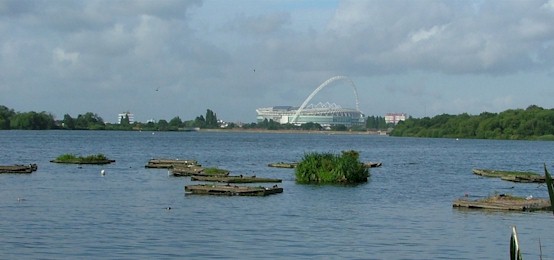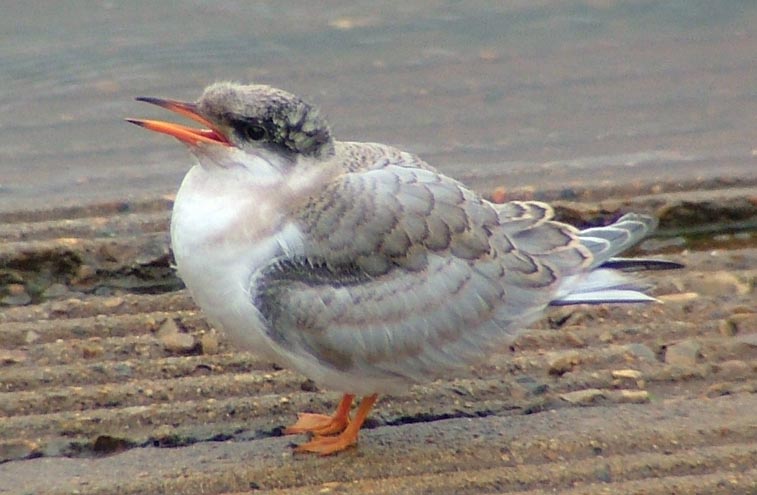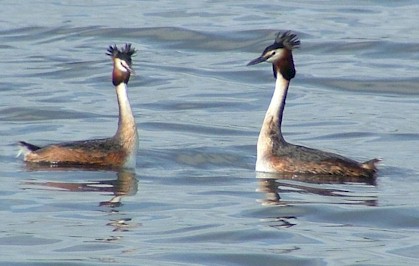Brent Reservoir
From Londonbirders
| Line 5: | Line 5: | ||
== Directions == | == Directions == | ||
| - | [[Image:Brentphoto.jpg]] | + | [[Image:Brentphoto.jpg|right]] |
| - | Also commonly known as the Welsh Harp, Brent Reservoir is a large reservoir with natural banks lying adjacent to the North Circular Road in Neasden and surrounded by marshland, woodland, unimproved grassland and playing fields. The main point of access is off West Hendon Broadway NW9 along Cool Oak Lane. You can park just before the bridge which crosses the reservoir or there is a car park at the top of Woodfield Park. | + | Also commonly known as the Welsh Harp, Brent Reservoir is a large reservoir with natural banks lying adjacent to the North Circular Road in Neasden and surrounded by marshland, woodland, unimproved grassland and playing fields. The main point of access is off West Hendon Broadway NW9 along Cool Oak Lane. You can park just before the bridge which crosses the reservoir or there is a car park at the top of Woodfield Park. NB. On weekdays there is no parking on Woolmead Avenue between 10.00-11.00. |
| - | + | For access using public transport there is Hendon rail station on Thameslink which is a 10 minute walk (closest to the hides): turn right out of station, walk down Station Road and left at the end onto West Hendon Broadway. Cross over and go down Cool Oak Lane) or Wembley Park underground station and then bus 297 or 182 to Blackbird Hill (get off at the stop opposite LIDL) and walk along Birchen Grove for the Dam (Western) end. | |
| - | |||
== Access == | == Access == | ||
| Line 17: | Line 16: | ||
There is open access to all of the reservoir although a key is required to access the hides. There are two hides overlooking East Marsh (follow the footpath which starts by the sailing base car park by the bridge) and one in the North Marsh (follow the footpath on the other side of the bridge). There's also a raised platform near the latter hide. | There is open access to all of the reservoir although a key is required to access the hides. There are two hides overlooking East Marsh (follow the footpath which starts by the sailing base car park by the bridge) and one in the North Marsh (follow the footpath on the other side of the bridge). There's also a raised platform near the latter hide. | ||
There is an active conservation group from whom a key for the hides is obtainable, telephone 020 8447 1810). | There is an active conservation group from whom a key for the hides is obtainable, telephone 020 8447 1810). | ||
| + | |||
| + | [[Image:Brentres1.jpg]] | ||
| + | |||
| + | '''View from the hide looking towards the dam with Wembley Stadium in the background''' (Photo by Andrew Self) | ||
== History == | == History == | ||
| Line 30: | Line 33: | ||
== Breeding Birds == | == Breeding Birds == | ||
| - | Mute Swan, Canada Goose, Gadwall, Mallard, Shoveler (occasionally), Pochard, Tufted Duck, Ruddy Duck, Little Grebe, Great Crested Grebe, Sparrowhawk, Kestrel, Moorhen, Coot, Lesser Black-backed Gull, Herring Gull, Common Tern, Feral Dove, Stock Dove, Woodpigeon, Collared Dove, Tawny Owl, Swift, Kingfisher, Green Woodpecker, Great Spotted Woodpecker, House Martin, Grey Wagtail, Pied Wagtail, Wren, Dunnock, Robin, Blackbird, Song Thrush, Mistle Thrush, Sedge Warbler, Reed Warbler, Lesser Whitethroat, Common Whitethroat, Garden Warbler, Blackcap, Willow Warbler, Chiffchaff, Goldcrest, Long-tailed | + | Mute Swan, Canada Goose, Gadwall, Mallard, Shoveler (occasionally), Pochard, Tufted Duck, Ruddy Duck, Little Grebe, Great Crested Grebe, Sparrowhawk, Kestrel, Moorhen, Coot, Lesser Black-backed Gull, Herring Gull (occasionally), Common Tern, Feral Dove, Stock Dove, Woodpigeon, Collared Dove, Tawny Owl, Swift, Kingfisher, Green Woodpecker, Great Spotted Woodpecker, House Martin, Grey Wagtail, Pied Wagtail, Wren, Dunnock, Robin, Blackbird, Song Thrush, Mistle Thrush, Sedge Warbler, Reed Warbler, Lesser Whitethroat, Common Whitethroat, Garden Warbler, Blackcap, Willow Warbler, Chiffchaff, Goldcrest, Long-tailed Tit, Blue Tit, Great Tit, Coal Tit, Jay, Magpie, Carrion Crow, Starling, House Sparrow, Chaffinch, Greenfinch, Goldfinch, Bullfinch, Reed Bunting. |
[[Image:AS_GCGrebe.jpg]] | [[Image:AS_GCGrebe.jpg]] | ||
Revision as of 10:58, 4 November 2009
Map: [1] Website: http://www.brentres.com
Contents |
Directions
Also commonly known as the Welsh Harp, Brent Reservoir is a large reservoir with natural banks lying adjacent to the North Circular Road in Neasden and surrounded by marshland, woodland, unimproved grassland and playing fields. The main point of access is off West Hendon Broadway NW9 along Cool Oak Lane. You can park just before the bridge which crosses the reservoir or there is a car park at the top of Woodfield Park. NB. On weekdays there is no parking on Woolmead Avenue between 10.00-11.00.
For access using public transport there is Hendon rail station on Thameslink which is a 10 minute walk (closest to the hides): turn right out of station, walk down Station Road and left at the end onto West Hendon Broadway. Cross over and go down Cool Oak Lane) or Wembley Park underground station and then bus 297 or 182 to Blackbird Hill (get off at the stop opposite LIDL) and walk along Birchen Grove for the Dam (Western) end.
Access
There is open access to all of the reservoir although a key is required to access the hides. There are two hides overlooking East Marsh (follow the footpath which starts by the sailing base car park by the bridge) and one in the North Marsh (follow the footpath on the other side of the bridge). There's also a raised platform near the latter hide. There is an active conservation group from whom a key for the hides is obtainable, telephone 020 8447 1810).
View from the hide looking towards the dam with Wembley Stadium in the background (Photo by Andrew Self)
History
The reservoir was completed in 1840 and the birdlife has been recorded since then (in fact it was 'birded' i.e. birds were shot during its construction). With such a long history inevitably it has an impressive list of rarities, such as the UK's first Iberian Chiffchaff in 1972. Other rarities include White-rumped Sandpiper, Hume's Warbler, Lesser Scaup, Blue-winged Teal and Great White Egret.
The site was designated an SSSI for its breeding wetland birds such as Great Crested Grebe, Pochard, Tufted Duck and Common Tern and is also now a Local Nature Reserve.
A recently fledged Common Tern at Brent Res (Photo by Andrew Self)
Breeding Birds
Mute Swan, Canada Goose, Gadwall, Mallard, Shoveler (occasionally), Pochard, Tufted Duck, Ruddy Duck, Little Grebe, Great Crested Grebe, Sparrowhawk, Kestrel, Moorhen, Coot, Lesser Black-backed Gull, Herring Gull (occasionally), Common Tern, Feral Dove, Stock Dove, Woodpigeon, Collared Dove, Tawny Owl, Swift, Kingfisher, Green Woodpecker, Great Spotted Woodpecker, House Martin, Grey Wagtail, Pied Wagtail, Wren, Dunnock, Robin, Blackbird, Song Thrush, Mistle Thrush, Sedge Warbler, Reed Warbler, Lesser Whitethroat, Common Whitethroat, Garden Warbler, Blackcap, Willow Warbler, Chiffchaff, Goldcrest, Long-tailed Tit, Blue Tit, Great Tit, Coal Tit, Jay, Magpie, Carrion Crow, Starling, House Sparrow, Chaffinch, Greenfinch, Goldfinch, Bullfinch, Reed Bunting.
Pair of Great Crested Grebes displaying at Brent Res (Photo by Andrew Self)




